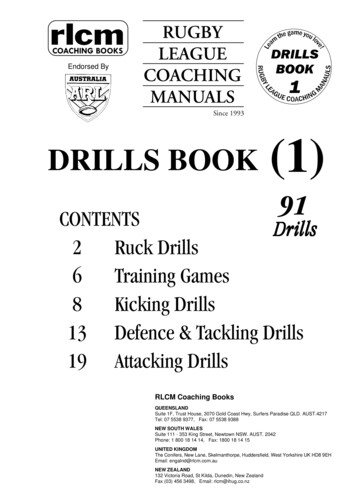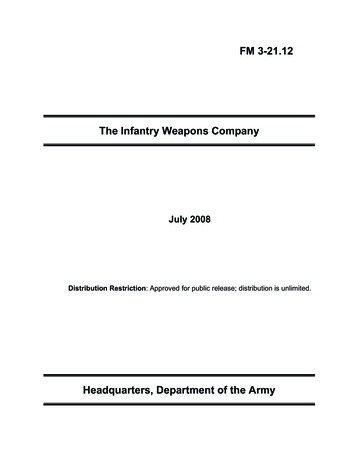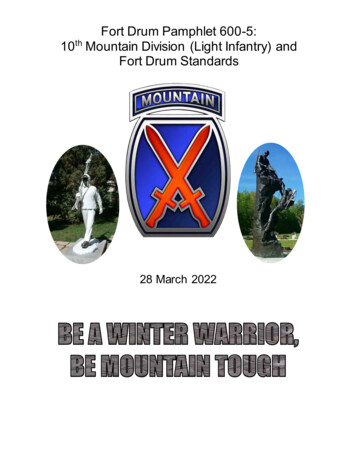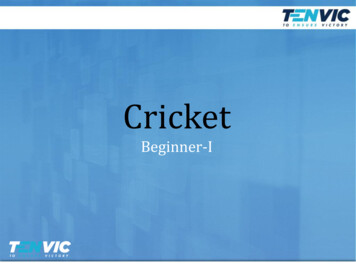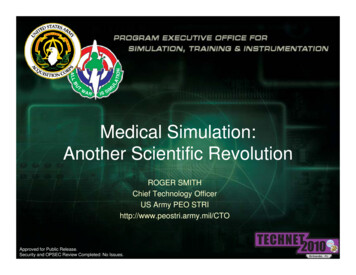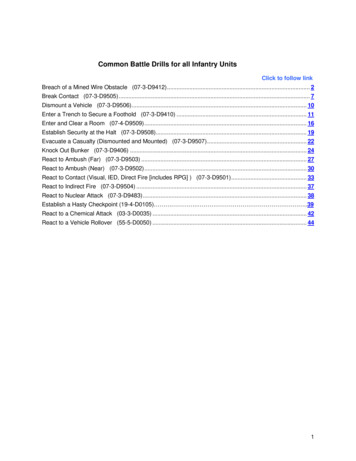
Transcription
Common Battle Drills for all Infantry UnitsClick to follow linkBreach of a Mined Wire Obstacle (07-3-D9412). 2Break Contact (07-3-D9505). 7Dismount a Vehicle (07-3-D9506). 10Enter a Trench to Secure a Foothold (07-3-D9410) . 11Enter and Clear a Room (07-4-D9509). 16Establish Security at the Halt (07-3-D9508). 19Evacuate a Casualty (Dismounted and Mounted) (07-3-D9507). 22Knock Out Bunker (07-3-D9406) . 24React to Ambush (Far) (07-3-D9503) . 27React to Ambush (Near) (07-3-D9502). 30React to Contact (Visual, IED, Direct Fire [includes RPG] ) (07-3-D9501). 33React to Indirect Fire (07-3-D9504) . 37React to Nuclear Attack (07-3-D9483). 38Establish a Hasty Checkpoint (19-4-D0105) . . .39React to a Chemical Attack (03-3-D0035) . 42React to a Vehicle Rollover (55-5-D0050) . 441
TASK: Breach of a Mined Wire Obstacle (07-3-D9412)CONDITIONS (CUE): The platoon encounters a mine wire obstacle preventing the company'smovement. The platoon's forward movement is stopped by a wire obstacle reinforced with mines thatcannot be bypassed. The enemy engages the platoon from positions on the far side of the obstacle.This drill begins when the unit's lead element encounters a mined wire obstacle and the unit leader ordersan element to breach the obstacle.STANDARDS: The platoon breaches the obstacle and moves all personnel and equipment quicklythrough the breach. The platoon moves the support element and follow-on forces through the breach andmaintains a sufficient fighting force to secure the far side of the breach.TASK STEPS AND PERFORMANCE MEASURES:1. A platoon's section/squad executes actions on contact to reduce effective fires from the far side ofthe obstacle.2. The section/squad in contact-a. Deploys -(1) Returns fire.(2) Seeks cover.(3) Establishes fire superiority.(4) Establishes local security.(5) Platoon sergeant repositions other squads to focus supporting fires and increaseobservation.b. Reports -(1) Squad leader reports location of hostile fire to platoon leader from base-of-fire positionusing the SALUTE format.(2) Platoon leader sends contact report followed by a size, activity, location, unit, time, andequipment (SALUTE) report to commander.3. Evaluate and develop the situation.a. The platoon leader quickly evaluates the situation with using the SITREPs from the squad incontact and his personal observations. At a minimum his evaluation should include includes-(1) Number of enemy weapons or volume of fire.(2) Presence of vehicles.(3) Employment of indirect fires.b. The platoon leader quickly develops the situation by-(1) Conducts a quick reconnaissance to determine enemy flanks.(2) Locates mutually supporting positions.(3) Locates any obstacles that impede the assault or provide some type of cover orconcealment.(4) Determines whether the force is inferior or superior.(5) Analyzes reports from squad leaders, teams in contact, or adjacent units.4. The platoon leader directs the vehicles (if available) and the squad in contact to support themovement of another squad to the breach point.a. Indicates the route to the base-of-fire position.b. Indicates the enemy position to be suppressed.c. Indicates the breach point and the route the rest of the platoon will take.d. Gives instructions for lifting and shifting fires.5. On the platoon leader's signal, the base-of-fire squad-a. Destroys or suppresses enemy weapons that are firing effectively against the platoon.b. Obscures the enemy position with smoke.c. Continues to maintain fire superiority while conserving ammunition and minimizing forces incontact.2
TASK STEPS AND PERFORMANCE MEASURES:6. The platoon leader designates one squad as the breach squad and the remaining squad as theassault squad once the breach has been made. (The assault squad may add its fires to the base-offire squad. Normally, it follows the covered and concealed route of the breach squad and assaultsthrough immediately after the breach is made.)7. The base-of-fire squad moves to the breach point and establishes a base of fire.8. The platoon sergeant moves forward to the base-of-fire squad with the second machine gun andassumes control of the squad.9. The platoon leader leads the breach and assault squads along the covered and concealed route.10. The platoon FO calls for and adjusts indirect fires as directed by the platoon leader to support thebreach and assault.11. The breach squad executes actions to breach the obstacle (footpath).a. The squad leader directs one fire team to support the movement of the other fire team to thebreach point.b. The squad leader designates the breach point.c. The base-of-fire team continues to provide suppressive fires and to isolate the breach point.(See Figure D9412-1)3
TASK STEPS AND PERFORMANCE MEASURES:Figure D9412-1. Breach obstacled. The breaching fire team, with the squad leader, moves to the breach point using the coveredand concealed route.4
TASK STEPS AND PERFORMANCE MEASURES:(1) The squad leader and breaching fire team leader employs smoke grenades to obscurethe breach point. The platoon base-of-fire element shifts direct fires away from thebreach point and continues to suppress adjacent enemy positions.(2) The breaching fire team leader positions himself and the automatic rifleman on oneflank of the breach point to provide close-in security.(3) The grenadier and rifleman (or the antiarmor specialist and automatic rifleman) of thebreaching fire team probe for mines and cut the wire obstacle, marking their path asthey proceed. (Bangalore is preferred, if available.)(4) Once the obstacle is breached, the breaching fire team leader and the automaticrifleman moves to the far side of the obstacle using covered and concealed positions.They signal the squad leader when they are in position and ready to support.e. The squad leader signals the base-of-fire team leader to move his fire team up and throughthe breach. He then moves through the obstacle and joins the breaching fire team, leavingthe grenadier (or antiarmor specialist) and rifleman of the supporting fire team on the nearside of the breach to guide the rest of the platoon through.f. Using the same covered and concealed route as the breaching fire team, the base-of-fireteam moves through the breach and to a covered and concealed position on the far side.12. The breach squad leader reports the situation to the platoon leader and posts guides at the breachpoint.13. The platoon leader leads the assault squad through the breach in the obstacle and positions it onthe far side to support the movement of the remainder of the platoon or to assault the enemyposition covering the obstacle.14. The breaching squad continues to widen the breach to allow vehicles to pass through.15. The platoon leader provides a situation report (SITREP) to the company commander and directs hisbreaching squad to move through the obstacle. The platoon leader appoints guides to guide thecompany through the breach point.Individual TasksTask 6-0511071-326-0512Task TitleConduct a Breach a MinefieldNeutralize Booby TrapsEngage Targets with an M249 Machine GunCorrect Malfunctions of an M240B Machine GunEngage Targets with an M240B Machine GunPerform Misfire Procedures on an M136 LauncherEngage Targets with an M136 LauncherEngage Targets with an M4 or M4A1 CarbineCorrect Malfunctions of an M4 or M4A1 CarbineCorrect Malfunctions of an M203 Grenade LauncherEngage Targets with an M203 Grenade LauncherCorrect Malfunctions of an M249 Machine GunEmploy Hand GrenadesMove as a Member of a Fire TeamMove Under Direct FireMove Over, Through, or Around Obstacles (Except Minefields)React to FlaresEstimate Range5
0-0005Select Temporary Fighting PositionsIssue a Fragmentary OrderIssue a Warning OrderControl Movement of a Fire TeamSelect an Overwatch PositionConduct the Maneuver of a SquadConduct Movement Techniques by a PlatoonConduct Movement Techniques by an M2 BFV Dismount PlatoonNavigate from One Point on the Ground to Another Point While DismountedAnalyze TerrainConduct a Leader's ReconnaissanceControl Organic FiresConduct the Maneuver of a PlatoonSupporting ProductsThe Infantry Rifle Platoon and Squad (FM 3-21.8)6
TASK: Break Contact (07-3-D9505)CONDITIONS (CUE): (Dismounted/Mounted) - The unit is stationary or moving, conducting operations.All or part of the unit is receiving enemy direct fire.The unit leader initiates drill by giving the order to "Break Contact."STANDARDS: (Dismounted/Mounted) - The unit returns fire. A leader identifies the enemy as a superiorforce, and makes the decision to break contact. The unit breaks contact using fire and movement. Theunit continues to move until the enemy cannot observe or place effective fire on them. The unit leaderreports the contact to higher headquarters.TASK STEPS AND PERFORMANCE MEASURES:1. Dismounted a. The unit leader designates an element to suppress the enemy with direct fire as the base-of-fireelement.b. The unit leader orders distance, direction, a terrain feature, or last rally point for the movementof the first element.c. The unit leader calls for and adjusts indirect fire to suppress the enemy positions.d. The base-of-fire element continues to suppress the enemy. (See Figure D9505-1)Figure 9505-1. Break contact (dismounted).e. The bounding squad/team uses the terrain and/or smoke to conceal its movement andbounds to an overwatch position.f. The bounding element occupies their overwatch position and suppresses the enemy with"well-aimed fire." (See Figure D9505-2)7
TASK STEPS AND PERFORMANCE MEASURES:Figure D9505-2. Break contact (dismounted) (continued).g. The base-of-fire element moves to its next covered and concealed position. (Based on theterrain and volume and accuracy of the enemy's fire, the moving element may need to usefire and movement techniques). (See Figure D9505-3)Figure D9505-3. Break contact (dismounted) (continued).h. The unit continues to suppress the enemy and bound until it is no longer in contact withenemy.i. The unit leader reports the contact to higher headquarters.2. Mounted a. The unit leader directs the vehicles in contact to place "well-aimed" suppressive fire on theenemy positions.b. The unit leader orders distance, direction, a terrain feature, or last objective rally point over8
TASK STEPS AND PERFORMANCE MEASURES:the radio for the movement of the first section.c. The unit leader calls for and adjusts indirect fire to suppress the enemy positions.d. Gunners in the base-of-fire vehicles continue to engage the enemy. They attempt to gain firesuperiority to support the bound of the moving section.e. The bounding section moves to assume the overwatch position.(1) The section uses the terrain and/or smoke to mask movement.(2) Vehicle gunners and mounted Soldiers continue to suppress the enemy.f. The unit continues to suppress the enemy and bounds until it is no longer receiving enemyfire.g. The unit leader reports the contact to higher headquarters.Individual TasksTask 0-0005113-571-1022Task TitleEngage Targets with an M249 Machine GunEngage Targets with an M240B Machine GunEngage Targets with an MK 19 Machine GunEngage Targets with an M136 LauncherEngage Targets with an M4 or M4A1 CarbineEngage Targets with an M16-Series RifleEngage Targets with an M203 Grenade LauncherEngage Targets with a Caliber .50 M2 Machine GunEmploy Hand GrenadesMove as a Member of a Fire TeamMove Under Direct FireSelect Temporary Fighting PositionsUse Visual Signaling TechniquesConduct the Maneuver of a SquadConduct Movement Techniques by a PlatoonControl Organic FiresConduct the Maneuver of a PlatoonPerform Voice CommunicationsSupporting ProductsThe Infantry Rifle Platoon and Squad (FM 3-21.8)The SBCT Infantry Rifle Platoon and Squad (FM 3-21.9)Warrior Ethos and Soldier Combat Skills (FM 3-21.75)9
TASK: Dismount a Vehicle (07-3-D9506)CONDITIONS (CUE): The unit is moving mounted and conducting operations as part of a larger element.The unit is ordered to DISMOUNT and provide security.The unit leader initiates drill by giving the order to "Dismount."STANDARDS: The unit moves to the best covered and concealed position available, which providesprotection for the dismounting personnel. When the command DISMOUNT is given, all Soldiers dismountin the order specified and clear the area per unit SOP. (An example technique is the 5-25 meters; eachSoldier immediately scans 5 meters around his position and then searches out to 25 meters based on theduration of the halt). Soldiers occupy positions, and vehicle gunners scan for enemy activity.TASK STEPS AND PERFORMANCE MEASURES:1. The unit leader selects a covered or concealed position as the dismount point.2. The unit leader gives the order to dismount (left or right) over the radio.3. Vehicle commanders monitor radios and alert the Soldiers in the vehicle.4. The drivers move their vehicles to the designated dismount point seeking the best cover andconcealment available.5. The driver stops the vehicle and the vehicle commander dismounts and occupies a security position.6. Soldiers dismount in the specified order, clear the area and move to covered and concealedpositions.7. The vehicles occupy overwatch positions and designated Soldiers man crew-served weapons andscan for enemy activity.8. Element leaders reposition their Soldiers as needed in overwatch positions.9. The unit leader reports to higher headquarters.Individual TasksTask Task TitleSelect Temporary Fighting PositionsUse Visual Signaling TechniquesSelect an Overwatch PositionPerform Voice CommunicationsSupporting ProductsThe SBCT Infantry Rifle Platoon and Squad (FM 3-21.9)Warrior Ethos and Soldier Combat Skills (FM 3-21.75)10
TASK: Enter a Trench to Secure a Foothold (07-3-D9410)CONDITIONS (CUE): The platoon is moving tactically and receives effective fire from an enemy trench.The platoon is ordered to secure a foothold in the trench. The platoon has only organic weapons supportavailable.The unit leader initiates drill by giving the order for the assault element to secure a foothold in the trench.STANDARDS: The platoon leader/squad leader quickly identifies the entry point. Platoon/squad securesthe entry point, enters the trench and secures an area large enough for the follow-on unit. The platoonmaintains a sufficient fighting force to repel enemy counterattack and continue the mission.TASK STEPS AND PERFORMANCE MEASURES:1. A platoon's section/squad executes actions on contact to eliminate or suppress fires from the trench.2. The section/squad in contact-a. Deploys -(1) Returns fire.(2) Seeks cover.(3) Establishes fire superiority.(4) Establishes local security.(5) Platoon sergeant repositions other squads to focus supporting fires and increaseobservation.b. Reports -(1) Squad leader reports location of hostile fire to platoon leader from base-of-fire positionusing the SALUTE format.(2) Platoon leader sends contact report followed by a size, activity, location, unit, time, andequipment (SALUTE) report to commander.3. Evaluate and develop the situation.a. The platoon leader evaluates the situation using the SITREPs from the squad in contact andhis personal observations. At the minimum his evaluation should include-(1) Number of enemy weapons or volume of fire.(2) Presence of vehicles.(3) Employment of indirect fires.b. The platoon leader quickly develops the situation by-(1) Conducts a quick reconnaissance to determine enemy flanks.(2) Locates mutually supporting positions.(3) Locates any obstacles that impede the assault or provide some type of cover orconcealment.(4) Determines whether the force is inferior or superior.(5) Analyzes reports from squad leaders, teams in contact, or adjacent units.4. Choose a COA.a. The platoon leader decides to enter the trench and selects his entry point.b. The platoon leader selects a covered and concealed route to his entry point.c. The platoon leader directs his maneuver element to secure the near side of the entry point andreduce the obstacle to gain a foothold.d. The platoon sergeant repositions the remaining squad to provide additional observation andsupporting fires.5. Executes COA (uses suppress, obscure, secure, reduce, assault [SOSRA] to set conditions for theassault). (See Figure D9410-1)11
TASK STEPS AND PERFORMANCE MEASURES:a. Suppress and obscure.(1) Platoon leader or FO calls for and adjusts indirect fire in support of assault.(2) Platoon sergeant directs base-of-fire squad to cover maneuvering squad.(3) Obscures maneuver element's movement with smoke, if available.b. Secures the near side and reduces the obstacle. Maneuver squad clears entry point.(1) Squad leader moves the assaulting squad to last covered and concealed position shortof the entry point.(2) Squad leader designates entry point.(3) Base-of-fire squad shifts fires from entry point and continues to suppress adjacentenemy positions.(4) Squad leader uses one team to suppress the entry point and positions the assaultingteam at the entry point.c. The platoon leader directs FO to shift indirect fires to isolate the OBJ and the base of firesquads to shifts fire as assault squad advances.d. Secures the far side and establishes a foothold. (See Figure D9410-2)12
TASK STEPS AND PERFORMANCE MEASURES:(1) The next two Soldiers position themselves against the edge of the trench to roll rightand left of the entry point to clear far side of obstacle and establish foothold.(2) Engage all identified or likely enemy positions with rapid, short bursts of automatic fireand scanned the trench for concealed enemy positions. The rest of the squad providesimmediate security outside the trench.(3) Team clears enough room for the squad or to the first trench junction and announces,"CLEAR."(4) Squad leader marks entry point in accordance with platoon SOP, then sends next teamin to increase the size of the foothold by announcing, "NEXT TEAM IN."(5) Team moves into trench and secures assigned area. (See Figure D9410-3)13
TASK STEPS AND PERFORMANCE MEASURES:(6)(7)(8)(9)Squad leader reports to platoon leader that the foothold is secure.Platoon leader moves to the maneuver squad leader to assess the situation.Platoon sergeant moves forward to control supporting squads outside the trench.The platoon leader sends necessary teams to clear an area large enough for theplatoon, and then reports to the commander that the foothold is secure and if additionalsupport is needed to continue clearing the trench.6. The platoon/squad leaders accounts for Soldiers, provides a situation report (SITREP) to higherheadquarters, reorganizes as necessary, and continues the mission.Individual TasksTask 326-0501Task TitleCorrect Malfunctions of an M9 PistolEngage Targets with an M9 PistolEngage Targets with an M249 Machine GunCorrect Malfunctions of an M240B Machine GunEngage Targets with an M240B Machine GunPerform Misfire Procedures on an M136 LauncherEngage Targets with an M136 LauncherEngage Targets with an M4 or M4A1 CarbineCorrect Malfunctions of an M203 Grenade LauncherEngage Targets with an M203 Grenade LauncherCorrect Malfunctions of an M249 Machine GunEmploy Hand GrenadesMove as a Member of a Fire Team14
1-410-0019Move Under Direct FireMove Over, Through, or Around Obstacles (Except Minefields)Select Temporary Fighting PositionsControl Movement of a Fire TeamControl Organic FiresSupporting ProductsThe Infantry Rifle Platoon and Squad (FM 3-21.8)15
TASK: Enter and Clear a Room (07-4-D9509)CONDITIONS (CUE): The element is conducting operations as part of a larger unit and your four Soldierteam has been given the mission to clear a room. Enemy personnel are believed to be in building. Noncombatants may be present in the building and are possibly intermixed with the enemy personnel.Support and security elements are positioned at the initial foothold and outside the building. Someiterations of this drill should be performed in MOPP4.This drill begins on the order of the unit leader or on the command of the clearing team leader.STANDARDS: The team secures and clears the room by killing or capturing the enemy, while minimizingfriendly casualties, non-combatant casualties and collateral damage; team complies with Rules ofEngagement (ROE). The team maintains a sufficient fighting force to repel an enemy counterattack andcontinue operations.TASK STEPS AND PERFORMANCE MEASURES:1. The element leader occupies a position to best control the security and clearing teams.a. Element leader directs a team to secure corridors or hallways outside the room withappropriate firepower.b. The team leader (normally the number two Soldier) takes a position to best control the clearingteam outside the room.c. The element leader gives the signal to clear the room.Note: If the element is conducting high intensity combat operations and grenades are being used, theelement must comply with the Rules of Engagement (ROE) and consider the building structure. A Soldierof the clearing team cooks off at least one grenade (fragmentation, concussion or stun grenade), throwsthe grenade into the room and announces, "FRAG OUT." The use of grenades should be consistent withthe ROE and building structure. Soldiers can be injured from fragments if walls and floors are thin ordamaged.2. The clearing team enters and clears the room.a. The first two Soldiers enter the room almost simultaneously. (See Figure D9509-1.)Figure D9509-1. Clear a room-first two Soldiers(1) The first Soldier enters the room and moves left or right along the path of leastresistance to one of two corners. He assumes a position of domination facing into theroom. During movement he eliminates all immediate threats.(2) The second Soldier (normally the team leader) enters the room immediately after thefirst Soldier. He moves in the opposite direction of the first Soldier to his point ofdomination. During movement he eliminates all immediate threats in his sector.Note: During high intensity combat the Soldiers enter immediately after the grenade detonates. BothSoldiers enter firing aimed bursts into their sectors engaging all threats or hostile targets to cover their16
TASK STEPS AND PERFORMANCE MEASURES:entry.Note: If the first or second Soldier discovers that the room is small or a short room (such as a closet orbathroom), he announces, "Short room" or "Short." The clearing team leader informs the third andfourth Soldiers whether or not to stay outside the room or to enter.b. The third Soldier moves opposite direction of the second Soldier while scanning and clearinghis sector as he assumes his point of domination. (See Figure D9509-2)c. The fourth Soldier moves opposite of the third Soldier to a position that dominates his sector.(See Figure D9509-3)Figure D9509-3. Clear a room-fourth Soldiersd. All Soldiers engage enemy combatants with precision aimed fire and identify non-combatantsto avoid collateral damage.Note: If necessary or on order, number one and two Soldier of the clearing team may move deeper intothe room while overwatched by the other team members.e. The team leader announces to the element leader when the room is "CLEAR."3. The element leader enters the room.a. Makes a quick assessment of room and threat.b. Determines if squad has fire power to continue clearing their assigned sector.c. Reports to the unit leader that the first room is clear.d. Requests needed sustainment to continue clearing his sector.e. Marks entry point IAW unit SOP.4. The element consolidates and reorganizes as necessary.17
Individual TasksTask 1-831-1046113-571-1022Task TitleCorrect Malfunctions of an M9 PistolEngage Targets with an M9 PistolEngage Targets with an M249 Machine GunCorrect Malfunctions of an M249 Machine GunSelect Hasty Firing Positions During an Urban OperationEngage Targets During an Urban OperationEmploy Hand Grenades During an Urban OperationPerform First Aid to Prevent or Control ShockTransport a CasualtyPerform Voice CommunicationsSupporting ProductsThe Infantry Rifle Platoon and Squad (FM 3-21.8)Combined Arms Operations in Urban Terrain (FM 3-06.11)18
TASK: Establish Security at the Halt (07-3-D9508)CONDITIONS (CUE): (Dismounted/Mounted) - The unit is moving tactically, conducting operations. Anunforeseen event causes the unit to halt. Enemy contact is possible.This drill begins when the unit to must halt and enemy contact is possible or the unit leader initiates drillby giving the order to "Halt."STANDARDS: (Dismounted) - Soldiers stop movement and clear the area per unit SOP. (An exampletechnique is the 5-25 meters; each Soldier immediately scans 5 meters around his position and thensearches out to 25 meters based on the duration of the halt). Soldiers occupy covered and concealedpositions, maintain dispersion and all-round security. (Mounted) - Vehicle commanders direct theirvehicles into designated positions, using available cover and concealment. Soldiers dismount in the orderspecified and clear the area per unit SOP. (An example technique is the 5-25 meters; each Soldierimmediately scans 5 meters around his position and then searches out to 25 meters based on theduration of the halt). The platoon/section members maintain dispersion and all-round security.TASK STEPS AND PERFORMANCE MEASURES:1. Dismounted a. The unit leader gives the arm-and-hand signal to halt.b. Soldiers establish local security.(1) Assumes hasty fighting positions using available cover and concealment.(2) Inspects and clears his immediate area (Example: using the 5-25 technique).(3) Establishes a sector of fire for his assigned weapon (Example: using 12 o'clock as thedirection the Soldier is facing, the Soldier's sector of fire will his 10 o'clock to 2 o'clock).c. Element leaders adjust positions as necessary.(1) Inspects and clears his element area.(2) Ensures Soldiers sector of fire overlap.(3) Coordinates sectors with the elements on his left and right.d. The unit leader reports the situation to higher headquarters.2. Mounted a. The unit leader gives the order over the radio to stop movement. (See Figure D9508-1)Figure D9508-1. Secure at halt (mounted).b. The unit halts in the herringbone or coil formation according to the unit SOP. (See Figure19
TASK STEPS AND PERFORMANCE MEASURES:D9508-2 and D9508-3)Figure D9508-2. Secure at halt (mounted) (herringbone) (continued).Figure D9508-3. Secure at halt (mounted) (coil) (continued).c. Each vehicle commander ensures his vehicle is correctly positioned, using cover andconcealment, and the crew served weapon is manned and scanning.d. Vehicle commanders order Soldiers to dismount to provide local security.e. Soldiers dismount and establish local security.(1) Moves to a covered and concealed position as designated by the leader.(2) Inspects and clears his immediate area (Example: using the 5-25 technique).(3) Establishes a sector of fire for his assigned weapon.f. Dismount element leaders adjust positions as necessary.g. The unit leader reports the situation to higher headquarters.20
Individual TasksTask Task TitleSelect Temporary Fighting PositionsUse Visual Signaling TechniquesPerform Voice CommunicationsOperate a Vehicle in a ConvoySupporting ProductsThe Infantry Rifle Platoon and Squad (FM 3-21.8)The SBCT Infantry Rifle Platoon and Squad (FM 3-21.9)Warrior Ethos and Soldier Combat Skills (FM 3-21.75)21
TASK: Evacuate a Casualty (Dismounted and Mounted) (07-3-D9507)CONDITIONS (CUE): The unit is stationary or moving, conducting operations. A Soldier has been injuredand must be evacuated. All enemy in the area has been suppressed, neutralized or destroyed and localsecurity is established. Some iterations of this drill should be performed in MOPP4.This drill begins when
TASK: Breach of a Mined Wire Obstacle (07-3-D9412) CONDITIONS (CUE): The platoon encounters a mine wire obstacle preventing the company's movement. The platoon's forward movement is stopped by a wire obstacle reinforced with mines that cannot be bypassed. The enemy engages the platoon from positions on the far side of the obstacle.

